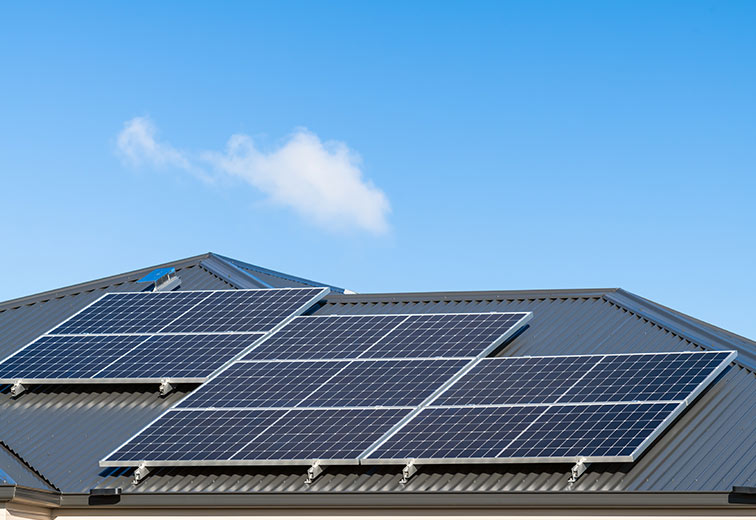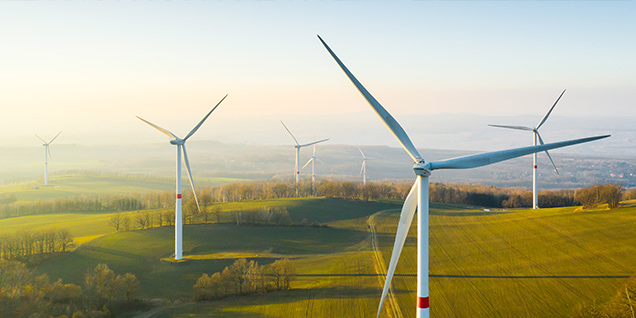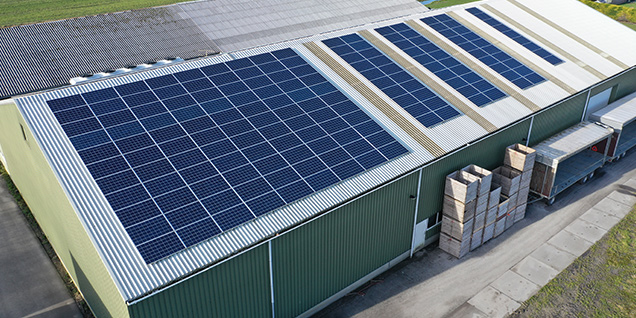Microgeneration for business
Electric Ireland is supporting customers on their low-carbon journey.
Electric Ireland is supporting customers on their low-carbon journey.

Microgeneration is the generation of green electricity from renewable technologies, such as solar panels, micro-wind, micro-hydro and micro-renewable combined heat and power (CHP).

The Government Microgeneration Support Scheme allows businesses with a registered microgeneration device to sell any excess electricity back to Ireland’s electricity grid. This payment is called a Clean Export Guarantee (CEG).

Most Electric Ireland microgenerators have solar PV installed on their roof. Your solar PV installer would have registered a connection form on your behalf to ESB Networks. This form provides us with the information we need to set you up.
Learn more about solar
Microgenerators generate clean, renewable energy to meet some or all of the electricity demands of a household or small business. When coupled with a diverter, this renewable energy can heat a water tank.
In the Republic of Ireland, the Government Microgeneration Support Scheme is now available so that those with a registered microgeneration device can sell any excess electricity back to Ireland’s electricity grid.
This will help businesses reduce their carbon footprint and save money.
The Clean Export Guarantee (CEG) is the payment eligible businesses will receive when they sell their “microgeneration” excess electricity back to the national grid. In the context of grid connection, “microgeneration” relates to capacities in the range 0 – 6 kW for single phase electrical connections, and in the range 0 – 11 kW for three phase connections.
Electric Ireland customers who own a micro-generator such as solar PV, micro-wind, micro-hydro, or renewable micro-CHP are eligible for this scheme.
You must have an export grid connection registered with ESB Networks on completion of grid application form available through their website. This is typically organised by the installer on installation or can be organised through ESB Networks directly. To receive the payment, customers must update us on their VAT registration status, and if registered for VAT, supply their VAT number and evidence. This is a Revenue requirement. The payment is in the form of a credit on the bill.
In addition, you must have a smart meter installed where technically possible. If you are not currently eligible to have a smart meter installed, then you will be paid based on a deemed export calculation.
If you are a small-scale generator in the 50-200kW range, you are also eligible for this support scheme however, the price you receive for export may differ from those applicable for microgeneration (below 50kW).
Please note that Electric Ireland endeavours to issue payments to our small-scale generation business customers in 2025. We appreciate our customer’s patience, and we are working to issue these payments as soon as we can.
Meanwhile, please obtain and complete the WP00014 form from ESB Networks and send this to us so we can commence processing your application.
Electric Ireland offers a rate of 21c per kWh from 15th Feb 2022. We estimate that this payment will range between €50-€300 per year, depending on the size and type of your microgeneration system (a typical installation of 10 panels would be about €150 per year).
All payments will be backdated to either 15th February 2022, or your registration date if later.
If you registered for VAT, we will manage the Value Added Tax (VAT) for microgeneration payments on your behalf. We will do this by issuing a Self-billing invoice, which is an invoice to ourselves on your behalf.
To issue you with a Self-billing invoice we will require your VAT registration number, if you are registered for VAT, For more information and a copy of your self-billing invoice, please register for, or visit your online account at businessonline.electricireland.ie.
If you are registered for Value Added Tax (VAT), we will manage the VAT aspect of microgeneration payments on your behalf under the Self-billing mechanism. We will do this by issuing a Self-billing invoice, which is an invoice to ourselves in respect of the supply of electricity to us. You can obtain a copy of this invoice for your own VAT records, via your online account at Business Online. This is the most convenient way for handling the VAT attributable on microgeneration. We will assume we have your agreement to this process unless you advise us otherwise. For further information, please see www.revenue.ie
How to access my self billing invoice on Business online
Simply log in to Business online. (If not registered simply click here to register. ) In Business Online click on the Reports tab along the top, scroll to the bottom of the reports tab. Click Microgeneration and this will open the Microgeneration page. Your Microgeneration accounts will be on this page. Click the account you wish to view the self billing invoice. You will now have the option to download your Self billing invoice.
Where possible, a smart meter is required to avail of microgeneration payments. Smart meters can measure the profile of demand at your business and thereby allow you to maximise your self-consumption. Smart meters can also measure the export of microgeneration installations to facilitate access to remuneration for residual electricity exported to the grid.
If you have a microgenerator installed, such as solar PV, ESB Networks will submit a connection form on your behalf. This form will inform us at Electric Ireland that you have a registered microgeneration device and ESB Networks will install a smart meter for you if you do not already have one.
If, for any reason, you cannot have a smart meter installed in your business, you will receive estimated payments based on the size of your installed microgeneration device. If you are eligible for an upgrade to a smart meter and refuse - or have previously refused - a smart meter installation, as offered by ESB Networks, you are ineligible for payment for your exported electricity.
If you have microgenerator such as solar PV and a standard 24hr smart meter, ESB Networks have prioritised you for smart meter installation and they will be in touch. Unfortunately, we cannot provide detail on a timeline. Please see www.esbnetworks.ie for information.
Yes. It is expected that day/night meters will be upgraded throughout 2024. Please see ESB Networks for information.
Deemed Export Quantity is the quantity of electricity, in kWh, which is determined to be exported, as calculated using this formula, from the Commission for Regulation of Utilities (CRU): MEC x Capacity Factor x Export Factor x Provision Interval
MEC, Maximum Export Capacity, is a capacity value in units of kW; it is representative of the generation capacity of the installed generation equipment, as declared via ESBN’s grid application form.
Capacity Factor is the ratio of average electricity produced to the theoretical maximum possible if the installed capacity was generating at a maximum for a full year. (set at 9.7%)
Export Factor is the amount of electricity (expressed as a percentage of electricity produced) deemed to be exported, where the metered data is not available. (set at 35%)
Provision Interval is the number of hours in the period for which cumulative export quantities are to be calculated and to be made available to suppliers by ESBN. (eg: "Provision Interval" of 12 months = 8760 hours)
Further information can be found at www.cru.ie.
Only Electric Ireland customers who meet the criteria above are eligible for the Microgeneration Scheme through Electric Ireland. For more information on being an Electric Ireland Business customer, please visit our home page.
Solar PV panels use the sun's energy to convert daylight into renewable energy. The electricity is then consumed within the premises, reducing your need to buy energy from a supplier. When a Solar PV system produces more energy than a business needs, the extra energy can go to your immersion heater or can be exported to the grid for payment. Solar PV is not to be confused with Solar Thermal - while Solar Thermal heats water only, Solar PV gives you free electricity and hot water. Most customers install solar PV on their roof, however they can be installed anywhere on your property where there is sufficient open space and good sun exposure. To learn more, visit Solar PV for Business.
It’s likely that your PV installer submitted a connection form on your behalf to ESB Networks. Once the form is processed, we, at Electric Ireland, are made aware that you have a microgeneration system at your property. If you do not hear from us, it's possible that a connection form has not been submitted for your microgenerator and you will need to contact your installer or ESB Networks for advice.
The connection form and associated information is available on ESB Networks website.
As soon as we know your VAT registration status, and if applicable, your VAT registration number, your first payment will be a backdated made in the form of a credit on your electricity bill. From then on, there will be a microgeneration credit on every bill for that bill period.